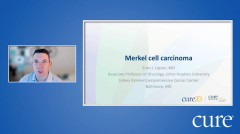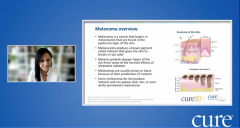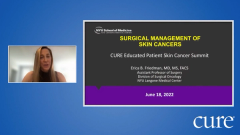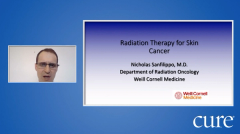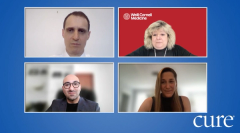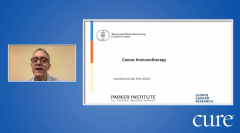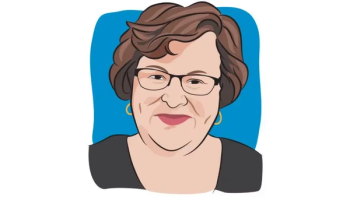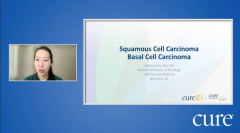
Educated Patient® Skin Cancer Summit Multidisciplinary Approach Panel: June 18, 2022
Watch Dr. Sherrif Ibrahim, Dr. Erica B. Friedman and Dr. Nicholas Sanfilippo answer questions about the multidisciplinary approach to care during the CURE Educated Patient Skin Cancer Summit.
This panel was moderated by Dr. Anna C. Pavlick and featured Dr. Sherrif Ibrahim, Dr. Erica B. Friedman and Dr. Nicholas Sanfilippo.
Pavlick: There's a question for Dr. Ibrahim. Are there any medical surveillance tests that a patient should consider while undergoing topical treatment?
Ibrahim: Oftentimes, we just see patients back because especially if it's their first time (receving topical treatment), it's very difficult for them to understand whether or not it's working, if they're applying it correctly, if they're putting the right amount on. You know, I often really demonstrate how much to put on, less is definitely more. Putting more on just makes things more inflamed, but doesn't necessarily make it work better. But we just see patients back and say, “Hey, you're doing a good job or do back off a little bit or do more.” There's not really a test you can do downstream once they're done. You know, sometimes we might do a repeat biopsy to make sure that the cancer is gone. But again, these are super thin cancers. So there has to be some surface change. If the skin is nice and smooth. Usually that means the cancer is gone.
Pavlick: Great. Thank you. This is another question coming back at you. As a result of immunotherapy for melanoma, I've lost some of the pigmentation on my face. Is there a treatment to reverse this? Is there a special makeup I could use to make it less evident?
Ibrahim: Well, this (is) something that we see a lot and we know that in patients who do get vitalized or depigmentation of their skin, they tend to do better with immunotherapy, it's often a good sign that they've had a beneficial effect. But of course, it can be very unsightly, there's no real pigmenting cream that we have, there is more we can depigment if there are just small areas of pigment left pretty well, but we can't bring the pigment back. Sometimes we use localized, or what's called an excimer laser, which just actually delivers UV to try to read pigment back. Oftentimes, it just comes back in time on in and of itself. There's a type of makeup called Derma blend, which is very good for covering that up. But you know, really any makeup that works is going to do the job. But, you know, again, the melanoma’s gone. So I think it's a good outcome.
Pavlick: Yes, agreed, you know, us as a medical oncologist, I know when my patients get the lygo, you know, that's a very exciting feature for me. It's not me who's living with it. And I understand that many times this does cause a lot of anxiety and distress for some patients, especially depending upon where they get it. And it's particularly bothersome, especially in my African American population, where this is really just blatantly obvious and very disturbing. So really, thank you for that answer. And hopefully we can in the future, we'll be able to find ways to get patients to repigment the areas they want to repigment.
There's a another question. And I guess I'm gonna throw this out to Dr. Friedman, as well as Dr. Sanfilippo. And the question is, what do I need to prepare to do prior to treatment/surgery?
Friedman: Not a whole lot. I think it largely depends on the extent of the surgery, but I would make sure that you speak with your surgeon during your consultation to truly know the extent of what you're getting into and what the plan is. Sometimes if you are going for a wide local excision and there's a plastic surgeon involved, there may be a lot of contingency plans on how to best close that. Oftentimes with ill-defined lesions that maybe aren't candidates for topical therapy but do require surgery. We don't allow definitive reconstruction at the initial operation. We prefer to do it in a staged fashion to ensure that the edges the margins are clear before complex repairs (are) performed. So in those cases, knowing that that's an option and being prepared for some even short-term wound care is important. Other than that, specific instructions will be given to you the day before the operation in terms of when to stop eating if you're having your operation under anesthesia, but generally, I would make sure to have as much answered before the day of your operation so that there's no surprises on a day that you're probably a little bit stressed.
Sanfilippo: Yeah, I would say very similar to that. For radiation, the radiation is a process. So there is time to sort of digest the information, come back and ask questions. And you'll usually be with your radiation team for a period of weeks, I tend to tell patients to try to keep their lives as normal as possible. Most of the time for cutaneous tumors. These almost all the time are outpatient treatments, people should continue to work and visit family friends do the things that they normally do. I think that tends to reduce the stress level a little bit. But by all means, as questions come up, ask your radiation team. And I think that will put a lot of concerns to rest.
Pavlick: Great, thank you. Now, we had a question about what do I do before. Now the question becomes, what kind of follow-up will I need after treatment? And so we can go in sequence. And, Nick, you're on the top of my screen, it'll be an Erica. And then Dr. Ibrahim will be last.
Sanfilippo: So typically, and let's say this is for treatment of the primary tumor, whether it's after surgery for adverse features, or primarily the reactions will tend to peak as I said, days to perhaps a week after so I tend to see patients at least twice within the first four weeks after treatment just to sort of see them through a period. And, you know, we will try to provide insight guidance, prescribe what we need to get them to that time period. Beyond that I actually never discharged patients, so I will see them even if it's once a year, usually in the first two years, it's about every six months, but then once a year, depending on the situation. And we'll continue to follow them. So from a radiation standpoint, certainly it's the first month or a little bit longer, where they're sort of coming out of the acute effects. But then we'll continue sort of a follow up with the other specialists but perhaps in a staggered way so that people aren't going to the doctor every two weeks.
Friedman: From the surgical perspective, I would say that it's fairly similar after your operation again, depending on the extent of the operation, will be a driver of how frequently you would need to see your surgeon in the immediate post op period. If I've removed multiple lymph nodes or all the lymph nodes in an area, I typically see a patient on a weekly basis until drains are removed, I'm sure the wounds are healed. On a long term perspective, I follow my patients roughly every four months. For anybody with anything other than a very thin or in situ melanoma every four months for a couple of years, and then I switched every six months and, like Dr. Sanfilippo, don't usually discharge patients so at five years I'll switch to annually. But I'm very clear with my patients that my follow up does not replace that of a dermatologist. I'm largely focused on recurrence at the site that I operated on and evaluating lymph nodes by doing an examination or any additional tests that are necessary, and I leave the total body skin checks for additional you know, new skin cancers to a dermatologist.
Ibrahim: For me, I feel like my job is to keep patients away from Dr. Sanfilippo and Dr. Friedman. Alright, so you know, I'm a dermatologic surgeon. So we do a lot of small removals of skin cancers, and topical treatments and so forth and work with the general dermatologists to make sure things don't either progress or come back. And so we see people depending on again, the severity of their cancer, the high risk squamous cell cancers and melanomas we can see every three months or so, you know, that are different melanomas can come back many, many years after treatment, whereas a squamous cell cancer if we make it to two or three years, we feel pretty comfortable that that's not going to come back and basal cell cancers, you know, rarely if ever metastasize. So again, the majority that we see are basal cells. So once they've recovered from their local surgery or their topical treatment, we tend to hand them back to the general dermatologist just for ongoing routine skincare. And so that I think is the foundation for all of what we do is the general dermatologist.
Pavlick: Great, thank you. Now there’s an interesting question regarding topical chemotherapy treatments. Do they have any systemic issues that patients need to worry about?
Ibrahim: That's a great question. And then something I think I omitted from my talk. Absolutely. So we have to be careful about applying topical treatments over large surface areas of the body, or you can get absorption into the bloodstream with either of the drugs I talked about. And that even with very low areas of application, people can still have flu-like symptoms, they can just feel kind of a general malaise where they just feel achy fevers, and so forth, in which case, we just stop the treatment and those things resolve.
Pavlick: Thank you. There's a radiation question for Dr. Sanfilippo. Do you ever just partially radiate, for example, the center of a tumor versus doing the entire the entire tumor?
Sanfilippo: Typically not. I'm trying to think of a case where I would do that. No, generally, we’re treating the whole tumor. I mean, you know, Dr. Pavlick and I have done a lot of radiation immunotherapy combinations, where a patient may have multiple lesions and we will treat one and not all of them with the idea of perhaps having a systemic response with the combination. But when we're treating a particular tumor, and it certainly in the primary setting, we are treating the entire tumor.
Pavlick: Great, thanks, Nick. There's the surgical question. Once the sentinel lymph node has been removed, what is the next step?
Friedman: Excellent question. And I'm sorry, I didn't make it to that part of my talk. But you know, if the lymph node is negative, then that's great news. The next step may be a referral to a medical oncologist depending on the ultimate stage. Or in that context, it could also just be surveillance in the setting of a positive sentinel lymph node. Again, a less-is-more approach is what we've shifted to. And recent data from a large-scale clinical trial has indicated that there is no survival benefit to going back and removing all of the rest of the lymph nodes. So in that case, if you have a melanoma and your sentinel node surveillance would include ultrasound of what we call basin or that area where the lymph nodes were removed, and most certainly a referral to medical oncology to discuss systemic therapy or treatment to the whole body to decrease the risk of spread.
Pavlick: Great, thank you. It may be because we have a little bit of time left. I'm gonna go back to Dr. Ibrahim and ask if you can maybe discuss a little bit about a procedure called the Mohs surgery…(what is it)? Who does it? And how is it done?
Ibrahim: I was hoping you would ask that question. So I am a Mohs surgeon. Mohs named after a doctor, Dr. Fred Mohs. That's not an acronym that stands for anything. It's just the doctor that developed the technique even way back in the 1940s at the University of Wisconsin, it is really meant for very localized, typically, basal cell cancer, squamous cell cancers, and just the very, very thin melanomas or melanoma inside you.
And it really provides two main goals. One is for margin control to really make sure that we track out these small basal cells and squamous cell cancers, which are notorious for having little roots or tentacles underneath the surface of the skin. So really tracking those out with a very microscopically controlled approach, where we the Mohs surgeon, who is this specially trained dermatologist who goes on to do additional training, we remove the cancer and while the patient waits, we take that specimen right to our lab in the office and check 100% of the peripheral or edges and deep margins and make sure that the cancer is all out, then that way we can remove more while the patient's still there and then repair it on the same day. And then the other thing it does is also preserve skin so in areas like the vital structures of the face, the nose, eyelids, lips, ears, so forth, where we want to leave a small mark as possible or where skin for repair is kind of at a premium or very tight. It allows us to make sure that the cancers are gone while the patient waits and to remove as little of the normal skin as possible, which is very important and really Mohs surgery has become the go-to treatment for small localized nonmelanoma skin cancers and very, very thin melanoma cancers, typically located on the head or neck area where we do see most of them.
Friedman: Can I just make a quick comment just to clarify for the audience, if you're not at a specialized center, though, most for melanoma, even in situ melanoma is controversial. not to step on your toes, Dr. Ibrahim, I don't know that it's the standard of care everywhere. Obviously spoken by a surgeon who doesn't do much. But if you're seeing somebody like Dr. Ibrahim at an academic medical center, certainly a possibility, but in the general community, it may not be.
Pavlick: Right. So we're just about at the end of questions, I'd like to go back to all of our panelists and just ask you for any final remarks or thoughts regarding the session, or things that you think need to be re-emphasize to our audience before we close. So we'll start with Dr. Sanfilippo.
Sanfilippo: Thank you. I think the take-home message is that it's important that we work as a team, not every tumor is appropriate for radiation, or surgery, or topical therapy. And you have different applications, depending on the clinical problem. So we all have our own area, which is our passion, and we enjoy it, and we believe in it. But it's important that we don't become siloed, but that we talk to each other work as a team so that each patient can have the best possible outcome.
Friedman: Well, Dr. Sanfilippo, you stole mine. I'm gonna also stress that we work as a team, the treatment of the majority of these skin cancers is multidisciplinary. It involves all the members here on your panel, every case may not. But it's important to recognize that your care may not be limited to a single individual, and that there are multiple members of your care team.
Ibrahim: I couldn't agree more. I mean, we meet once a week with all the specialists involved in all the specialists that are represented here on today's panel. And we just talk about what the best thing is to do, it's not appropriate for one person to be to drive the drive the ship on their own, but really to get the input of everyone that's involved to optimize the outcome for our patients.
Pavlick: Yeah, I agree. I think what the take home for pretty much all of the sessions earlier, as well as this one is that care is not a cookie cutter. Everybody doesn't get the same thing. You just don't go to a recipe book and say, “Oh, melanoma, you get this squamous cell basal cell, you get this.” That it really does take a village to make a successful outcome for a patient. And so input through the multidisciplinary team really makes care personalized for all of our patients so that patients do get the best cosmetic outcome as well as the best overall survival outcome.
This transcription was edited for clarity.
For more news on cancer updates, research and education, don’t forget to

